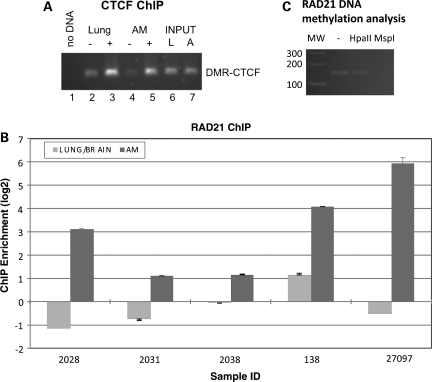Figure 5.
CTCF and cohesin binding in the UPGL alternative promoter. (A) ChIP-PCR analysis of CTCF in adrenal gland (noted AM or A) or lung (noted LUNG or L) tissues from the 2028 sample. − and + indicate mock- or CTCF-specific immunoprecipitation. Input indicates total chromatin prior to immunoprecipitation. The ChIP-PCR is analyzed by agarose gel electrophoresis. (B) The results from ChIP-qPCR analysis of cohesin binding at the DMR using an antibody against RAD21, a component of cohesin. Three paired fetal lung and adrenal medulla tissues from three fetuses (numbers 2028, 2031, 2038) and two paired fetal brain and adrenal medulla tissues from two fetuses (numbers 138 and 27097) were analyzed by cohesin ChIP. The fold enrichment values are determined by determining the threshold cycle numbers for the ChIP DNA and input control DNA. In all experiments, the adrenal tissue shows increased RAD21 binding. Increased RAD21 binding is also noted in one of two fetal brains (number 138) consistent with frequent methylation at HpaII restriction sites observed in fetal brains. (C) Restriction enzyme digestion of the RAD21 ChIP DNA with HpaII or MspI (which both cut DNA at CCGG sites, but HpaII is blocked by CG methylation) and PCR analysis shows that Rad21 ChIP DNA is resistant to HpaII digestion, while PCR failed to amplify the specific product from MspI-digested ChIP DNA, suggesting that significant fraction of RAD21 bound DNA is methylated. (MW, molecular weight marker in base pairs. Lane ‘–’ was not treated by restriction enzyme.)

